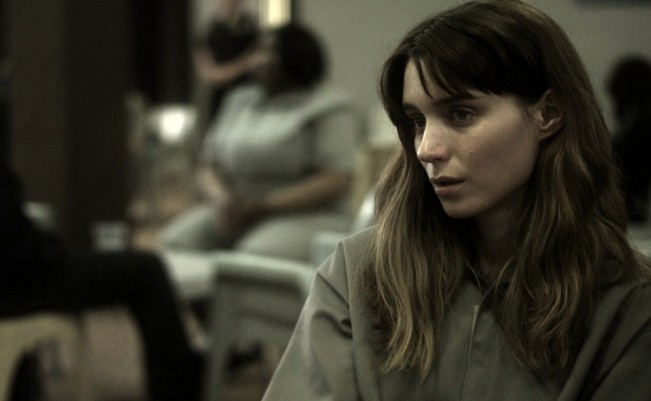

By Ray Pride Pride@moviecitynews.com
New On DVD: Lore, Side Effects
Lore
Cate Shortland’s exquisite second feature, her first since her 2004 debut, the cunningly, thrillingly detailed Somersault, makes you wonder why we’ve missed two or three Cate Shortland features in the meantime. Australia’s 2012 Oscar entry for Best Foreign Language Film, Lore is a brute coming-of-age story about five German children who scatter across the countryside in the spring of 1945 as the Allied forces claim the country. (“Laura” is the pronunciation of the diminutive of “Hannelore,” the Nazi-indoctrinated teenager’s name.)
Shortland’s the sort of filmmaker, you watch a scene unfold and you simply say to yourself, I remember, yes, this is what movies ought to look like, what movies can look like, with casting, color, composition, tempo: they can tactile, empathetic, empathic, detailed, suggestive, bold, fragile and altogether a thing of life and dream at once. The blue of inked numerals on forearm effaced by tugging down a deep blue wool sleeve; glisten of child’s blue eyes above rudely blushing mouth, ants prickling at a the vinous red darkened onto a blooded thigh; figurines emblematic of innocence crushed with grown-ups’ finality: painterly yet photographic conjuring.
I could go a couple hundred words about lead Saskia Rosendahl’s emotional translucence: Shortland is in thrall to her potential, her simmering consciousness. Adam Arkapaw, whose credits include the brooding, majestic look of David Michôd’s Animal Kingdom and the bleak, bustling Snowtown, is key to Shortland’s accelerated-decelerated-heartbeat Terrence Malick-scale beauty, more closely tethered to stakes of her characters’ lives and our own dread from historical hindsight than elevated spiritual maunderings. Weather is never just weather, light is never just light. Gorgeous and masterful, Lore is pretty close to great. Max Richter’s lovely, anxious, pervasive score is bristling, bursting and bold.
Side Effects
 A tricky, sardonic thriller shot after the fashion of Adrian Lyne’s sexual-remorse thrillers like Fatal Attraction and Unfaithful, Side Effects is a revival of a script by Scott Z. Burns (Contagion, The Informant!) that Soderbergh took up after a “Man From U. N. C. L. E.” revival collapsed. A psychiatrist, Dr. Jonathan Banks (Jude Law), is assigned a patient who’s apparently tried to harm herself, Emily Taylor (Rooney Mara) after the release of her husband (Channing Tatum) from prison after four years on inside trading charges. A succession of drugs (all with real names) doesn’t help, until a new (fictional) one seems to: Ablixa. But the thrills (and an ample aptitude for suspension of disbelief) come from questions of culpability and being wronged, rather than the pharma folderol.
A tricky, sardonic thriller shot after the fashion of Adrian Lyne’s sexual-remorse thrillers like Fatal Attraction and Unfaithful, Side Effects is a revival of a script by Scott Z. Burns (Contagion, The Informant!) that Soderbergh took up after a “Man From U. N. C. L. E.” revival collapsed. A psychiatrist, Dr. Jonathan Banks (Jude Law), is assigned a patient who’s apparently tried to harm herself, Emily Taylor (Rooney Mara) after the release of her husband (Channing Tatum) from prison after four years on inside trading charges. A succession of drugs (all with real names) doesn’t help, until a new (fictional) one seems to: Ablixa. But the thrills (and an ample aptitude for suspension of disbelief) come from questions of culpability and being wronged, rather than the pharma folderol.
To argue that any movie is a reflection of its process is reductionist, yes, but in the case of Soderbergh’s recent exit interviews—bold, affirmative, assertive, sometimes even strident—Side Effects is a well of perhaps inadvertent self-reflection, down to the smallest details, “I just don’t think movies matter as much anymore, culturally,” Soderbergh told New York magazine in a pre-SIFF keynote interview. And one of his characters says, “There’s a reason we have rules,” and another, “I remember that structure really helps with hopelessness.” And a paranoiac statement that everyone knows everything is also clever inversion of William Goldman’s iconic statement about Hollywood: “Nobody knows anything.”
But Soderbergh knows how to make a sleek thriller, and such keen professionalism would be missed, from the film’s bookends, fine cynicism as chilly as the ending of Contagion, to its prismatic, centripetal play with who the central character really is. (Preview screenings around the country were affixed with a sign, “The screening has now started. Due to the non-linear nature of this film, it would be unrewarding for you to enter at this point… Best regards, The Filmmakers.”)
The screenplay is rich with dovetailing and rhymes. One small stirring comes from Emily’s fingers whirring at a patch of white fray on a hospital coverlet, a detail matched later to the airy weave of the model’s white cable-knit sweater in a commercial for Ablixa.) Complicated convolutions impress with cleverness but not the highest degree of plausibility. The cautious withholding of important information is key to its reversals, an alchemical cocktail with a few drugs missing. But the sweetly percolating tension in Thomas Newman score, along with the precision of physical characterization and adroit editing bundle things along. Still, climaxes and anti-climaxes spatter like cold rainfall. (This is not a warm movie.)
Soderbergh’s career-long, emblematic foot fetishism is also put forward, with Rooney’s shoes choreographed to her character’s fashion moodiness and motivational ambiguity, including red flats as she drives carelessly to black flats in another mood as she makes a show of herself on a subway platform. Then there is a screen nearly filled with Rooney’s upturned soles with the patina of a certain pink painted there. (The color red’s most forceful appearance may be the fantastic, emphatic high flush on her cheeks after an accident.) An almost too-perfectly parsed description of how she and her husband met includes the Soderberghian refractions, “He stared at me like I was a painting,” as well as, “Time goes by so fast.”
The style of the film is comprised largely of medium close-up head-and-shoulders studies of the actors; a set of counter-shots between Law and Rooney in their first psychiatric session are in themselves gorgeous portraiture. A late scene amplifies this, when in reverse angles, first Rooney, then Law, are out of focus, then lean into the shallowest, most precise focus while laying out the terms of an understanding. The light ranges from porcelain to gray, a beautiful Manhattan Woody Allen would go wide eyes at, steering clear of the yellow furze of recent Soderbergh movies like Magic Mike and The Informant! Among the neatly delineated elements, Banks’ fastidious but slightly outdated way of dressing marks the doctor as out of his league, as does an office where the coffee table in his exam room lacks almost all character, except a stack of books crowned by Malcolm Gladwell’s bulletins of societal self-help, “Blink” and “Outliers.” The most evocative recurring ingredient, beyond the close-ups on Law’s now-weathered face and Mara’s endlessly complex eyes, may be in the production design: the walls behind characters in their offices and homes capture lonely figures and lonelier streets. The interior walls of the city, the inner life of their minds. The life of the mind: a frightening landscape all its own.















